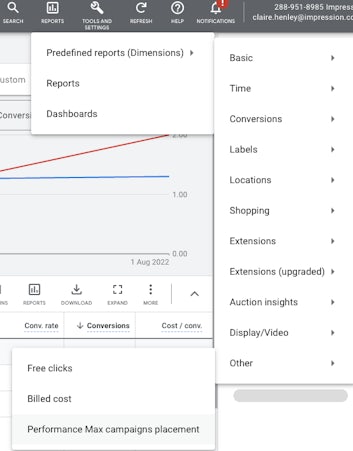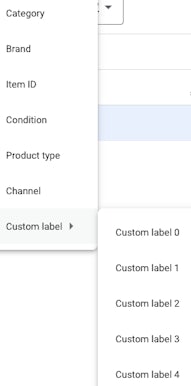Launched in November 2021, Performance Max is a campaign type within Google Ads that allows advertisements to automatically optimise their campaigns, by deploying assets across the full range of Google ad properties (Search, Shopping, Display, Discovery, Gmail and YouTube), to get more out of their spend. Based on machine learning, Performance Max analyses cross-channel data to help advertisers increase their click-through rates, conversions and ROI.
Google promotes Performance max as an evolution of Smart Shopping and is automatically upgrading these campaigns to Performance Max. Advertisers should be aware of this change and key difference between Performance Max and Smart Shopping as they plan for future campaigns. Performance max supports the full spectrum of conversion goals for a brand whether this be online sales, lead generation, Omni channel sales, store visits, and recently launched new customer acquisition.
Smart Shopping was launched in 2018, and marked Google’s first step in driving the shopping channel towards machine learning. This campaign type would optimise towards your conversion goals through Shopping ads, Local Inventory ads, and Display ads. Performance Max goes much further, not only by deploying cross-network targeting across all Google ad properties, but also by utilising all of Google’s automation technologies – from audience targeting to creative a/b testing – in pursuit of your conversion goals. The downside is that, while Performance Max relies on machine learning to hone its targeting and bidding algorithms, it doesn’t tell us much about this process.
This blog will provide you with actionable takeaways to help you assess and report on performance, alongside how to incorporate learnings from PMax performance into your other wider marketing mix.
- How does Performance Max differ from Smart Shopping?
- Visibility within Performance Max
- Interaction across Search & Performance Max
- Performance Max for ecommerce
- Performance Max for B2B
- Managing your asset groups
- Using the insights feature
- Our thoughts
- New features
- New Customer Acquisition
- Account wide negatives
- Video creation tool
- Experiments
- Upcoming features
- Asset reporting
- Brand exclusions
- Page feeds
How does Performance Max differ from Smart Shopping?
Smart Shopping has now been automatically upgraded to Performance Max. Old Smart Shopping campaigns are therefore set to ‘removed’ in Google Ads accounts, which means their data is still visible but they can’t be used. Standard Shopping campaigns can still be used, but it’s worth bearing in mind that if there’s an Performance Max campaign targeting the same products, it will always take priority over Standard Shopping.
It’s nigh on impossible to do a clean data comparison between Smart Shopping and Performance Max; even when they could be run in tandem, PMax would absorb Smart Shopping’s traffic. Generally, though, across our client base, Performance Max campaigns are meeting or exceeding targets, particularly in eCommerce.
One thing to be mindful of as you settle into your new PMax campaigns is reviewing impressions. You’ll likely see a large % increase – this will mainly be coming from PMax’s channel expansion to Display, YouTube, Discover and other ad formats – and the increase is not specifically your products or ads suddenly taking over the shopping space.
Visibility within Performance Max
Performance Max sells itself that it should work alongside other campaign types such as search, discovery & display. However, there is very limited visibility on where the traffic, sales and reach is coming from within the campaign. Something that we all hope for is for Google to add this to its reporting features as the campaign increases in use.
We can however see some top line figures as to where our ads are showing on placements and placement types within the report feature in Google Ads – Reports > Predefined > Other > Performance Max placements.

When setting up and launching Performance Max campaigns, it is best to follow the guidelines as instructed by Google, with all the assets, headlines, video & feed implemented into the campaign. Google’s video builder, however, can help you create video creatives if you lack them (found under tools & settings > asset library > + video). From the assets provided, you can add custom text and music to create a video.
Interaction across Search & Performance Max
The interaction between search & performance max campaigns allows you to gain incremental search coverage for any search terms that do not match/are identical to a current keyword in your account and when a query is not identical, the campaign with the highest ad rank will be chosen to serve.
For search terms that match a keyword, these will continue to go through your current search campaigns.
Performance Max for ecommerce
If you’re an ecommerce brand that is reliant on Smart Shopping campaigns, it’s likely you are used to including all of your eligible products into one campaign. With Performance Max, you may still wish to follow this approach and therefore agree with Google’s best practice advice of grouping all items together.
On the basis that a client had no access to assets, we would advise on using Performance Max for the retail section only, and focus on the shopping feature. While you can’t fully control where PMax campaigns serve, you can limit its potential channel use by leaving the asset group empty when creating the campaign. It’s important to note, however, that Performance Max without assets can still serve in Search, by pulling headlines from your website like a Dynamic Search Ad, and in Display, by using images from your Merchant Center Feed.
Shopping campaigns have previously covered the shopping space and have been heavily reliant on the feed. Performance Max opens a door for your brand to be visible across a wider variety of platforms and despite product price still playing a key role in most ads, it enhances product feed ads by allowing you to showcase a broader range of USPs attached to your product and brand.
Performance Max for B2B
With Performance Max being marketed as the new Smart Shopping, lead generation businesses can still benefit. PMax can be created without a Shopping feed and paired with offline conversion data, so the algorithm can understand which leads resulted in sales, allowing you to focus on Search, Display, YouTube and Discovery campaigns.
You have two options here to improve lead quality. One is to split Performance Max campaigns by goal types (e.g. email signups, form completions) and choose specific CPAs for each. The other is to utilise Google’s value-based bidding, assigning incremental conversion value to each step of the lead generation process. That way, Google will place a higher value on leads that progress further down the funnel.
Managing your asset groups
Asset groups are Performance Max’s take on ad groups. When you set up a PMax campaign with a shopping feed, asset groups are directly tied to listing groups, which are simply sets of products from the shopping feed, filtered however you’ve chosen. While you can’t set campaign goals at the asset group level like you used to be able to with ad groups, they allow you to tie specific sets of assets to specific sets of products to make sure you’re serving the most relevant ad to the right user at the right time.
While Smart Shopping allowed you to filter products via multiple custom labels, Performance Max now only gives you the option to filter by one. It’s still beneficial to use this feature where possible to split campaigns out at product level, so you can set different ROAS targets per product category e.g clothing or instruments, as well as having specific assets and copy too.
One way that you can compare asset groups is by running different messaging. A strategic approach that we have tested is comparing bottom of the funnel messaging (wanting your users to purchase or take action) to top of the funnel messaging (for users who may be less likely to buy). From here, we can analyse engagement and conversion statistics, then allocate resources equitably across short and long-term strategies as current business and competitive contexts demand.
Once you have gathered enough data via these asset groups, you can broaden this out into specific campaigns that each have different strategies and targets.
For example, your top of the funnel campaign with generic messaging & call to actions may have a lower ROAS or higher CPA target, as you aren’t encouraging users to purchase or take action. Whereas your bottom of funnel campaign that has clear messaging & strong call to actions may target a higher ROAS and lower CPA as you’ll likely generate more sales or leads from this tailored copy.
One strategy could be to look at using different funnel stages and adjust the targets, whether that be ROAS or CPA, based on this.
However, unlike when you have tried this before for social or display activity, PMax audience signals are not strict, confined targets. Therefore, if you apply in market or affinity audiences to the top of the funnel campaign and remarketing audiences to the bottom of the funnel campaign, it does not mean you are only going to be showing to these users only. Performance Max is a growth-focused campaign type, and it seeks to help you unlock new customer segments. In fact, you can set Performance Max to optimise towards (and therefore bid more aggressively for) new customers. This is particularly useful if you have strong customer retention, or measure lifetime value.
Using the insights feature
Whilst the insights report feature is currently fairly basic, it does clearly show what’s working, trends and search terms. All of which can help inform strategies, albeit at a fairly top level at the moment.
You must allow enough time for your campaigns to gather the right amount of data before Google can provide you with meaningful insights.
You are able to view search terms that have triggered your ads to appear in the consumer spotlight section which highlights the terms, their revenue, search volume and which asset group they fell through into. This was something that Smart Shopping did not do, in comparison to Performance Max. But whilst still being a ‘black box’, PMax provides us with a bit more information here than Smart Shopping did!

Within the Asset Group > View Detail section, you can assess where your ads and campaigns can improve by analysing Google’s rating of elements such as your headlines and assets.
This level of insight may also be beneficial for your wider marketing team who might use the information to feed into other campaigns such as email, ATL or social media activity. It will give an idea as to what is and isn’t working and whether anything is worthwhile trailing across other channels.
Our thoughts
Like it or loathe it, Performance Max is only going to start being used more widely.
Here are some of our top tips and takeaways for you to trial in your own campaigns:
- Utilise default filters or maximise the use of custom labels to filter through certain products or ranges that you would to separate out e.g. pricing, categories, brands.
- This will help you to have clearer visibility based on your data set and the performance certain brands or categories are having.

- Refrain from running Smart Shopping & Performance Max campaigns at the same time – in most cases Smart Shopping won’t even serve at all! Performance Max will take priority over Smart Shopping and once the campaign is out of the learning stage, you’ll see your smart shopping campaigns stop spending. Once PMax runs out of daily budget, Smart Shopping Campaigns will then serve. Be aware that if you use the upgrade feature to change Smart Shopping to PMax, the Smart Shopping campaign will be deleted.
- Ask your agency to speak with their Google rep to ensure all negative keywords are applied to your campaigns so that your brand guidelines are still adhered to.
- Use the asset groups to trial different copy and image variants within one campaign. This could be subtle differences in messaging, changing calls to actions or using different types of creatives.
- Performance Max doesn’t give us much in terms of control aside from the inputs (creatives & product feed) and the outputs (goal, placements and conversion setup). If you’re relying on shopping campaigns specifically, feed optimisation and strong creatives alongside a/b testing are key to ensure that the feed aspect of the campaign will continue to perform at an optimum level. It’s vital to ensure you do not neglect your feed.
New features
New Customer Acquisition
There is a new feature with the performance max campaign set up that now allows you to target new customers – with the campaigns being either set to bid only for new customers, this option will restrict ads to only show to new customers or to bid higher for new customers over returning customers, this option will optimise bids for new customers but will not be limited to new users only.
Within this feature, it is best practice to use customer lists to help the campaign and bidding strategy know who are previous/current customers, but you can also use remarketing lists too.
Within e-commerce accounts that have a purchase/revenue-focused goal, you can apply the additional value that a new customer brings vs. a returning customer i.e returning customer=£50, new customer=£100, so we would set the new customer value to £50.
For lead generation accounts, this feature can still be applied without adding value for new customers but is advised. Therefore, it is beneficial to have CRM platforms integrated so you are able to see how much each lead has generated.
The aim of this campaign type & feature is to help grow overall sales or lead volume, but with this campaign optimising towards new customers whom you’d then aim will bring long-term customer retention and revenue for your brand.
With having a broader reach due to targeting new customers, the ROAS or CPA targets would need to be adjusted to consider this difference in performance you may see.
Account wide negatives
You can now apply up to 1000 negative keywords to your performance max campaigns, without needing to go through your Google rep to add these.
This is music to a lot of brands’ & agencies’ ears as we now have more control over where ads show and minimise traffic that you don’t want to reach.
Video creation tool
More video templates have been added to the video creation tool as mentioned earlier in the blog. This is helping brands to create videos to utilise within performance max that may not have a YouTube channel.
It is worth noting that a video in performance max either has to be created in the platform using this tool or be provided in the form of a youtube link. Native brand videos cannot be uploaded.
Experiments
Now have the capabilities to run a/b tests for performance max campaigns either by –
Running uplift experiments to understand how performance max performs alongside other campaigns and helping to show the benefit of multi-channel performance.
Or by running a test on Performance max vs. standard shopping. Helps outline the difference in transitioning from the two different campaign types and to show the benefit of AI, cross-channel campaign type – performance max.
This is good to trial for accounts who have been used to standard shopping & who may still be a little dubious in handing the reins over completely to Google.
Upcoming features
Asset reporting
This will be a great benefit to accounts where you may be testing different copy, and different assets.
This new feature will be on top of the already available insights but there will now be other metrics to report on such as cost, sales, and revenue.
Brand exclusions
- Helps to control what brands your campaigns match to.
- Brand names will be pre-populated by Google in the drop-down box but there is the option to request a different brand if the one you would like to exclude is not available.
- This feature will then stop your ads from showing against specific brands in both search & shopping.
Page feeds
- This feature now allows you to specify which landing pages/URLs are most relevant and want to send traffic to.
- The current feature ‘final URL expansion’ is a little 50/50 of people who chose to opt into this feature, as by keeping this on you are allowing Google to send users to other landing pages, other than the one you have specified in your ad, so it is worth noting that this new feature does work alongside URL expansion in that if selected to be ON Google will not just restrict users to these landing pages but it will if the setting it set to OFF.
Stay up-to-date in the world of PPC and Paid Media in our blog. Need further support on Performance Max? Get in touch if you have any questions.



